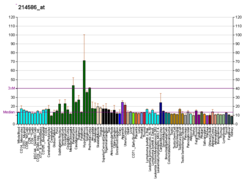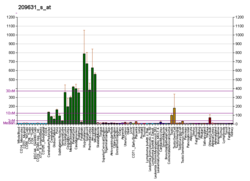GPR37 (original) (raw)
From Wikipedia, the free encyclopedia
Protein-coding gene in the species Homo sapiens
Probable G-protein coupled receptor 37 is a protein that in humans is encoded by the GPR37 gene.[5][6][7] GPR37 is primarily found in the central nervous system (CNS), with significant expression observed in various CNS regions including the amygdala, basal ganglia (caudate, putamen, and nucleus accumbens), substantia nigra, hippocampus, frontal cortex, and hypothalamus, particularly noteworthy is its exceptionally elevated expression in the spinal cord.[8]
GPR37 has been shown to interact with HSPA1A[9] and Parkin (ligase).[9][10] GPR37 is a receptor for prosaposin. It was previously thought to be a receptor for head activator, a neuropeptide found in the hydra, but early reports of head activator in mammals were never confirmed.[11] To address challenges in confirming ligand-GPR37 interactions using recombinant GPR37 expressed in HEK293 cells, recent research has turned to primary cell cultures, leading to successful ligand identification.[12] These investigations have unveiled the involvement of osteocalcin with GPR37 to regulate processes such as oligodendrocyte differentiation, myelination, myelin production, and remyelination following demyelinating injuries.[13] Furthermore, osteocalcin treatment has demonstrated protective effects against Lipopolysaccharide-induced inflammation, which are absent in GPR37-deficient mice.[14]
GPR37 signaling has been shown to modulate the migration of olfactory ensheathing cells (OECs) and gonadotropin-releasing hormone (GnRH) cells in mice.[15]
- ^ a b c GRCh38: Ensembl release 89: ENSG00000170775 – Ensembl, May 2017
- ^ a b c GRCm38: Ensembl release 89: ENSMUSG00000039904 – Ensembl, May 2017
- ^ "Human PubMed Reference:". National Center for Biotechnology Information, U.S. National Library of Medicine.
- ^ "Mouse PubMed Reference:". National Center for Biotechnology Information, U.S. National Library of Medicine.
- ^ Marazziti D, Golini E, Gallo A, Lombardi MS, Matteoni R, Tocchini-Valentini GP (October 1997). "Cloning of GPR37, a gene located on chromosome 7 encoding a putative G-protein-coupled peptide receptor, from a human frontal brain EST library". Genomics. 45 (1): 68–77. doi:10.1006/geno.1997.4900. PMID 9339362.
- ^ "Entrez Gene: GPR37 G protein-coupled receptor 37 (endothelin receptor type B-like)".
- ^ Bolinger AA, Frazier A, La JH, Allen JA, Zhou J (September 2023). "Orphan G Protein-Coupled Receptor GPR37 as an Emerging Therapeutic Target". ACS Chemical Neuroscience. 14 (18): 3318–3334. doi:10.1021/acschemneuro.3c00479. PMC 11144446. PMID 37676000. S2CID 261580509.
- ^ Lonsdale J, Thomas J, Salvatore M, Phillips R, Lo E, Shad S, et al. (GTEx Consortium) (June 2013). "The Genotype-Tissue Expression (GTEx) project". Nature Genetics. 45 (6): 580–585. doi:10.1038/ng.2653. PMC 4010069. PMID 23715323.
- ^ a b Imai Y, Soda M, Hatakeyama S, Akagi T, Hashikawa T, Nakayama KI, Takahashi R (July 2002). "CHIP is associated with Parkin, a gene responsible for familial Parkinson's disease, and enhances its ubiquitin ligase activity". Molecular Cell. 10 (1): 55–67. doi:10.1016/S1097-2765(02)00583-X. PMID 12150907.
- ^ Imai Y, Soda M, Inoue H, Hattori N, Mizuno Y, Takahashi R (June 2001). "An unfolded putative transmembrane polypeptide, which can lead to endoplasmic reticulum stress, is a substrate of Parkin". Cell. 105 (7): 891–902. doi:10.1016/S0092-8674(01)00407-X. PMID 11439185. S2CID 721363.
- ^ Meyer RC, Giddens MM, Schaefer SA, Hall RA (June 2013). "GPR37 and GPR37L1 are receptors for the neuroprotective and glioprotective factors prosaptide and prosaposin". Proceedings of the National Academy of Sciences of the United States of America. 110 (23): 9529–9534. Bibcode:2013PNAS..110.9529M. doi:10.1073/pnas.1219004110. PMC 3677493. PMID 23690594.
- ^ Liu B, Mosienko V, Vaccari Cardoso B, Prokudina D, Huentelman M, Teschemacher AG, Kasparov S (November 2018). "Glio- and neuro-protection by prosaposin is mediated by orphan G-protein coupled receptors GPR37L1 and GPR37". Glia. 66 (11): 2414–2426. doi:10.1002/glia.23480. PMC 6492175. PMID 30260505.
- ^ Qian Z, Li H, Yang H, Yang Q, Lu Z, Wang L, et al. (October 2021). "Osteocalcin attenuates oligodendrocyte differentiation and myelination via GPR37 signaling in the mouse brain". Science Advances. 7 (43): eabi5811. Bibcode:2021SciA....7.5811Q. doi:10.1126/sciadv.abi5811. PMC 8535816. PMID 34678058.
- ^ Qian Z, Liu C, Li H, Yang H, Wu J, Liu J, et al. (April 2022). "Osteocalcin Alleviates Lipopolysaccharide-Induced Acute Inflammation via Activation of GPR37 in Macrophages". Biomedicines. 10 (5): 1006. doi:10.3390/biomedicines10051006. PMC 9138386. PMID 35625743.
- ^ Saadi H, Shan Y, Marazziti D, Wray S (2019). "GPR37 Signaling Modulates Migration of Olfactory Ensheathing Cells and Gonadotropin Releasing Hormone Cells in Mice". Frontiers in Cellular Neuroscience. 13: 200. doi:10.3389/fncel.2019.00200. PMC 6521704. PMID 31143101.
- Zeng Z, Su K, Kyaw H, Li Y (April 1997). "A novel endothelin receptor type-B-like gene enriched in the brain". Biochemical and Biophysical Research Communications. 233 (2): 559–567. doi:10.1006/bbrc.1997.6408. PMID 9144577.
- Donohue PJ, Shapira H, Mantey SA, Hampton LL, Jensen RT, Battey JF (February 1998). "A human gene encodes a putative G protein-coupled receptor highly expressed in the central nervous system". Brain Research. Molecular Brain Research. 54 (1): 152–160. doi:10.1016/S0169-328X(97)00336-7. PMID 9526070.
- Imai Y, Soda M, Inoue H, Hattori N, Mizuno Y, Takahashi R (June 2001). "An unfolded putative transmembrane polypeptide, which can lead to endoplasmic reticulum stress, is a substrate of Parkin". Cell. 105 (7): 891–902. doi:10.1016/S0092-8674(01)00407-X. PMID 11439185. S2CID 721363.
- Imai Y, Soda M, Hatakeyama S, Akagi T, Hashikawa T, Nakayama KI, Takahashi R (July 2002). "CHIP is associated with Parkin, a gene responsible for familial Parkinson's disease, and enhances its ubiquitin ligase activity". Molecular Cell. 10 (1): 55–67. doi:10.1016/S1097-2765(02)00583-X. PMID 12150907.
- Yang Y, Nishimura I, Imai Y, Takahashi R, Lu B (March 2003). "Parkin suppresses dopaminergic neuron-selective neurotoxicity induced by Pael-R in Drosophila". Neuron. 37 (6): 911–924. doi:10.1016/S0896-6273(03)00143-0. PMID 12670421. S2CID 8430695.
- Imai Y, Soda M, Murakami T, Shoji M, Abe K, Takahashi R (December 2003). "A product of the human gene adjacent to parkin is a component of Lewy bodies and suppresses Pael receptor-induced cell death". The Journal of Biological Chemistry. 278 (51): 51901–51910. doi:10.1074/jbc.M309655200. PMID 14532270.
- Kubota K, Niinuma Y, Kaneko M, Okuma Y, Sugai M, Omura T, et al. (June 2006). "Suppressive effects of 4-phenylbutyrate on the aggregation of Pael receptors and endoplasmic reticulum stress". Journal of Neurochemistry. 97 (5): 1259–1268. doi:10.1111/j.1471-4159.2006.03782.x. PMID 16539653. S2CID 24540976.
- Omura T, Kaneko M, Okuma Y, Orba Y, Nagashima K, Takahashi R, et al. (December 2006). "A ubiquitin ligase HRD1 promotes the degradation of Pael receptor, a substrate of Parkin". Journal of Neurochemistry. 99 (6): 1456–1469. doi:10.1111/j.1471-4159.2006.04155.x. hdl:2115/17141. PMID 17059562. S2CID 6256027.







